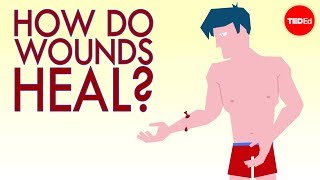(单词翻译:单击)
The largest organ in your body isn't your liver or your brain.
你身体中最大的器官并非肝脏,也不是大脑。
It's your skin, with a surface area of about 20 square feet in adults.
而是皮肤,一个成年人的皮肤展开面积约为1.86平方米。
Though different areas of the skin have different characteristics,
虽然人体不同部位的皮肤有着不同的特征,
much of this surface performs similar functions, such as sweating, feeling heat and cold, and growing hair.
但绝大多数都承担着相似的功能,比如排汗、感受冷热以及生长毛发等。
But after a deep cut or wound, the newly healed skin will look different from the surrounding area,
当皮肤被深度切伤或创伤时,新愈合的部分看上去总会有别于周围皮肤,
and may not fully regain all its abilities for a while, or at all.
并且可能在短期内,或者永久性地失去部分功能。
To understand why this happens, we need to look at the structure of the human skin.
要究其原因,我们先来看看人体皮肤的结构。
The top layer, called the epidermis, consists mostly of hardened cells, called keratinocytes, and provides protection.
皮肤最外面的一层叫做表皮,主要由一些硬化细胞组成,叫做角化细胞,能够提供保护作用。
Since its outer layer is constantly being shed and renewed, it's pretty easy to repair.
由于表皮本身会经常性地脱落与再生,要修复它也较为容易。
But sometimes a wound penetrates into the dermis,
但有时候,一些创口伤及真皮层,
which contains blood vessels and the various glands and nerve endings that enable the skin's many functions.
而真皮层中含有的血管、多种腺体和神经末梢是皮肤多种功能的保障。
And when that happens, it triggers the four overlapping stages of the regenerative process.
当深度伤口产生时,皮肤将进入由四个相互重叠的阶段构成的再生过程。
The first stage, hemostasis, is the skin's response to two immediate threats:
第一阶段,凝血,是皮肤在应对以下威胁:
that you're now losing blood and that the physical barrier of the epidermis has been compromised.
你正在失血,并且表皮层的物理屏障已被攻破。
As the blood vessels tighten to minimize the bleeding,
为减少出血,血管发生紧缩,
in a process known as vasoconstriction, both threats are averted by forming a blood clot.
这一过程叫做血管收缩,产生的血凝块能够帮助消除皮肤遭受的两大威胁。
A special protein known as fibrin forms cross-links on the top of the skin,
此外,一种叫做血纤维蛋白的特殊蛋白质在皮肤表面形成交叉网状结构,
preventing blood from flowing out and bacteria or pathogens from getting in.
以防止血液的流出和细菌病菌的侵入。
After about three hours of this, the skin begins to turn red, signaling the next stage, inflammation.
第一阶段持续大约三小时后,皮肤开始变红,这意味着第二阶段的到来,即炎症反应阶段。
With bleeding under control and the barrier secured,
此时失血已得到控制,保护屏障也已形成,
the body sends special cells to fight any pathogens that may have gotten through.
人体开始派出特殊的细胞抵抗可能已经入侵的病菌。

Among the most important of these are white blood cells, known as macrophages,
这些细胞中最重要的就是白细胞,也被称作巨噬细胞,
which devour bacteria and damage tissue through a process known as phagocytosis, in addition to producing growth factors to spur healing.
除了产生生长因子加速愈合,它们还能够吞噬细菌和损伤的组织,这一吞噬的过程叫做吞噬作用。
And because these tiny soldiers need to travel through the blood to get to the wound site,
因为这些体型微小的战士需要通过血液到达伤口,
the previously constricted blood vessels now expand in a process called vasodilation.
之前收缩的血管此时将发生扩张,这一过程叫做血管舒张。
About two to three days after the wound, the proliferative stage occurs, when fibroblast cells begin to enter the wound.
大约在受伤后的两到三天,成纤维细胞开始进入伤口,意味着第三阶段--增殖阶段的到来。
In the process of collagen deposition, they produce a fibrous protein called collagen in the wound site,
在胶原沉积的过程中,成纤维细胞能在伤口处产生一种纤维状的蛋白质,名为胶原蛋白,
forming connective skin tissue to replace the fibrin from before.
它能形成皮肤结缔组织,以取代之前的血纤维蛋白。
As epidermal cells divide to reform the outer layer of skin, the dermis contracts to close the wound.
当表皮细胞分裂重新形成外保护层,真皮层也在收缩以闭合伤口。
Finally, in the fourth stage of remodeling,
最后一个阶段是组织重组阶段,
the wound matures as the newly deposited collagen is rearranged and converted into specific types.
随着新沉积的胶原蛋白重组和转化为特定的形态,伤口变得成熟。
Through this process, which can take over a year, the tensile strength of the new skin is improved,
这一过程可能会持续一年以上,随后新生皮肤的伸缩强度就会得到提高,
and blood vessels and other connections are strengthened.
血管和其它连接组织也得到增强。
With time, the new tissue can reach from 50-80% of some of its original healthy function,
随着时间的推移,新生组织能够恢复到原先五成到八成的功能,
depending on the severity of the initial wound and on the function itself.
依据伤口的严重程度以及皮肤原先功能的好坏。
But because the skin does not fully recover,
但是因为皮肤并没有完全复原,
scarring continues to be a major clinical issue for doctors around the world.
疤痕仍是全世界医生主要关注的临床问题。
And even though researchers have made significant strides in understanding the healing process,
虽然通过研究,人们对皮肤伤口愈合的过程有了更深入的认识,
many fundamental mysteries remain unresolved.
但许多重要谜团仍未解开。
For instance, do fibroblast cells arrive from the blood vessels or from skin tissue adjacent to the wound?
比如,成纤维细胞到底来自血管,还是来自伤口周围的皮肤组织?
And why do some other mammals, such as deer, heal their wounds much more efficiently and completely than humans?
又比如,为什么诸如鹿之类的其它哺乳动物,相比人类能够更有效更彻底地修复它们的伤口?
By finding the answers to these questions and others,
通过寻求此类问题的答案,
we may one day be able to heal ourselves so well that scars will be just a memory.
人类也许有一天能有足够的修复能力,那时疤痕困扰也将成为历史。


